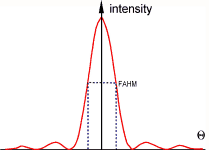Nonlinear optical crystals
Using the nonlinear properties of transparent crystals new frequencies can be generated from existing laser lines. A large variety of crystals are available. KOMLAS offers high quality KTP-, BBO- and LBO- crystals. The right material should be chosen taking into consideration the criteria transmission, damage threshold, efficiency of the nonlinear effect, phase matching range and laser beam quality.
The transmission of KTP, BBO and LBO respectively are shown below.
| KTP | BBO | LBO |
 |
||
The damage threshold is a function of the wavelength of fundamental and harmonic radiation, pulse duration, beam profile and other parameters.
For guidance typical values are given in the table (λ = 1064 nm, pulse duration 1.3 ns).
max. energy density [J/cm²]:
-
KTP 4.6
BBO 9.9
LBO 18.9
An electromagnetic wave propagating in a crystal excites oscillations of the charge density. With a usually small amplitude (depending on type of crystal and on the intensity of excitation) these oscillations contain higher harmonic terms. By using appropriate crystals in this way a new wave can be generated with a frequency different from those of the input waves.
The most common schemes of frequency conversion are: sum frequency generation with frequency doubling and tripling as special cases, difference frequency generation, optical parametric amplification and oscillation.
Sum frequency generation (SFG)
ω1 + ω2 = ω3 (1/λ1 + 1/λ2 = 1/λ3)

For example:
-
1064 nm + 532 nm-> 355 nm
2ω1 = ω2 (λ1 = 2λ2)
Optical Parametric Generation (OPG)
Optical parametric generation is the inverse process of sum frequency generation. It splits one high-energy photon into two lower-energy photons.
ωp = ωs + ωi (1/λp = 1/λs + 1/λi)

If the crystal is placed between two mirrors (end and outcoupling mirrors) of a cavity an optical parametric oscillator is established. Starting from the photon noise signal and idler waves are build up and amplified in each round trip in the resonator. The wavelengths of the generated signal and idler waves are determined by the phase matching condition.

optical parametric oscillator
Because phase matching is a function of crystal orientation and temperature optical parametric oscillators can be tuned by turning the crystal or changing its temperature.
In order to obtain considerable conversion efficiency in addition to the above demonstrated energy conservation relation a phase matching condition has to be met. Using second harmonics generation as an example the concept of this condition may be illustrated in the following way: At all points along the beampath in the NLO crystal small portions of the harmonic wave are generated. The phase of each portion is equal to the phase of the fundamental wave at the generation point. In order to obtain constructive interference of all the portions at the end of the crystal it is necessary to have the same phase velocity for the fundamental and the harmonic wave. This can be accomplished by utilizing the different refractive index for ordinary and extraordinary beams in birefringent crystals. By selecting the direction of the extraordinary beam (critical phasematching) or tuning temperature (noncritical phasematching if the beams propagate along x-, y- or z-direction) the phase velocities of both beams can be made equal within a certain wavelength range of the fundamental wave (phase matching range). In the more general case of a nonlinear optical frequency conversion the phase matching condition must be treated as momentum conservation for the involved photons.
For deviations of wave propagation from the phase matching direction the conversion efficiency is reduced. The acceptance angle (ΔΘ) is defined as the full angle at which the conversion efficiency falls to the half value of its maximum (FAHM). In the same way a temperature acceptance and a spectral acceptance is defined.

acceptance angle
Due to the birefringence of NLO crystals the extraordinary wave (e-ray) will be split from the ordinary wave by Pointing vector walk-off. If the beam size is small the generated beam will separate from the input beam thus limiting the conversion efficiency (OPG, OPA) and giving rise to beam profile deterioration (SHG).
